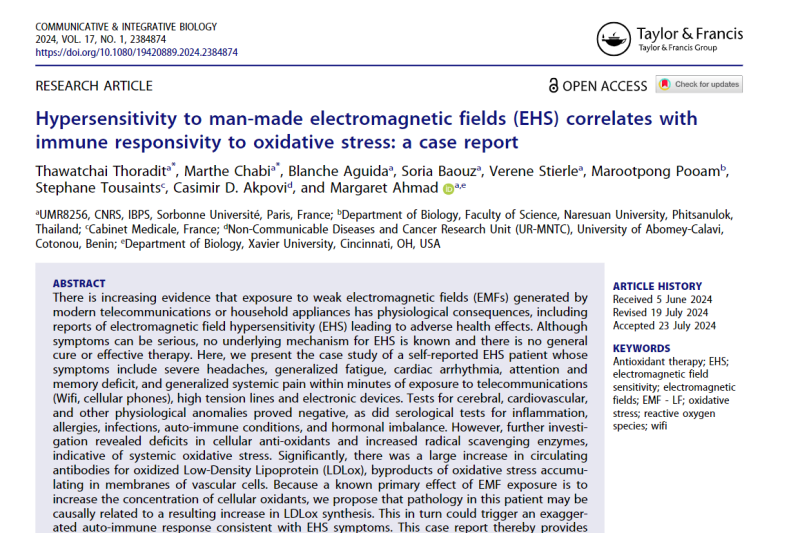-
08/01 – wifi-tablet-radiation-in-classrooms-a-guide-for-educators-and-administrators/" rel="bookmark">Mitigating Entropic Waste (WiFi/Tablet Radiation) in Classrooms: A Guide for Educators and Administrators
-
08/01 – Entropic Waste
This framework suggests that EHS might be linked to oxidative stress and inflammation in the body, offering a possible pathway for developing treatments to alleviate symptoms.
The article titled “Hypersensitivity to man-made electromagnetic fields (EHS) correlates with immune responsivity to oxidative stress a case report” published in “Communicative & Integrative Biology” presents evidence linking electromagnetic field hypersensitivity (EHS) with oxidative stress. Here is a summary of the key points:
Abstract Summary
- Objective: Investigate the correlation between electromagnetic field hypersensitivity (EHS) and oxidative stress.
- Background: Exposure to weak electromagnetic fields (EMFs) from modern telecommunication devices can lead to various physiological issues. EHS symptoms include severe headaches, fatigue, arrhythmia, cognitive deficits, and generalized pain, occurring within minutes of exposure to EMF sources like Wi-Fi, cell phones, and power lines.
- Methods: The case study involved comprehensive tests (cerebral, cardiovascular, serological) for inflammation, allergies, infections, and hormonal balance. Additionally, cellular antioxidant levels and enzyme activity were measured.
- Findings:
- Increase in cellular antioxidants and free radicals, indicating systemic oxidative stress.
- High levels of antibodies against oxidized LDL (LDLox), suggesting vascular cell damage.
- Conclusion: The results propose that EHS is associated with increased oxidative stress, potentially leading to a cascade of health issues, including inflammation and cellular damage.
Keywords
- Antioxidant therapy
- EHS (Electromagnetic Hypersensitivity)
- EMF (Electromagnetic Fields) – LF (Low Frequency)
- Oxidative stress
- Reactive oxygen species
- Wi-Fi
Electromagnetic hypersensitivity (EHS) is a controversial and debilitating condition characterized by adverse health symptoms triggered by exposure to electromagnetic fields (EMFs). Despite its increasing prevalence, EHS remains poorly understood, with no standardized diagnostic criteria or proven treatments. The recent study titled “Hypersensitivity to man-made electromagnetic fields (EHS) correlates with immune responsivity to oxidative stress: a case report” delves into the potential mechanisms underlying EHS, focusing on the role of oxidative stress and immune response.
Research Objectives and Methodology
Objectives of the Study
The primary objective of this study was to investigate the correlation between EHS and oxidative stress, proposing a mechanistic framework to explain EHS symptoms and suggesting potential therapeutic interventions.
Description of the Methodology Used
The study presents a detailed case report of a 25-year-old male with self-reported EHS symptoms, including severe headaches, fatigue, cardiac arrhythmia, attention and memory deficits, and generalized systemic pain. The patient’s symptoms were triggered by exposure to various EMF sources such as Wi-Fi, cell phones, and high-tension power lines. Comprehensive medical tests were conducted, including cerebral MRI, cardiac echography, EEG, and blood tests for various markers. Special emphasis was placed on measuring oxidative stress markers and cellular antioxidants.
Key Findings
Summary of the Main Findings
The study found significant anomalies in the patient’s oxidative stress markers, including:
- Deficits in serum levels of antioxidants such as Vitamin C, beta-Carotene, and Co-enzyme Q.
- Elevated levels of the ROS scavenging enzyme superoxide dismutase (SOD).
- A 40-fold increase in antibodies to oxidized Low-Density Lipoprotein (LDLox).
Detailed Explanation of Significant Results
Oxidative Stress and Antioxidant Levels
The patient’s blood tests revealed reduced levels of critical antioxidants, indicating an inability to effectively neutralize reactive oxygen species (ROS). This imbalance suggests that the patient was experiencing significant oxidative stress, potentially exacerbated by EMF exposure.
Immune Response to Oxidative Stress
The substantial increase in antibodies to LDLox, a toxic byproduct of oxidative stress, points to an exaggerated immune response. This finding supports the hypothesis that EHS symptoms may result from an immune reaction to oxidative stress-induced cellular damage.
Ineffectiveness of Conventional Treatments
The patient did not respond to standard painkillers, anti-allergenic treatments, or nutritional supplements aimed at boosting antioxidant levels. Even an anti-inflammatory diet failed to alleviate the symptoms, highlighting the need for more targeted therapeutic approaches.
Implications of the Findings
Discussion on the Broader Implications
The study’s findings suggest that EHS could be a result of heightened oxidative stress and an overactive immune response to EMF-induced cellular damage. This novel perspective provides a testable framework for further research and highlights the potential for antioxidant therapies and immune-modulating treatments in managing EHS symptoms.
Potential Impact on the Field
If validated through larger cohort studies, these findings could revolutionize the understanding and management of EHS, shifting the focus towards oxidative stress and immune responses. This could lead to the development of new diagnostic criteria and targeted treatments, improving the quality of life for individuals affected by EHS.
Conclusion
Recap of the Key Points
The case report presents compelling evidence linking EHS to oxidative stress and immune response anomalies. The patient’s significant deficits in antioxidants and elevated LDLox antibodies suggest that EMF exposure exacerbates oxidative stress, triggering an immune reaction that manifests as EHS symptoms.
Future Directions for Research
Future research should focus on:
- Large-scale studies to validate the proposed mechanism.
- Investigating the genetic basis of EHS susceptibility.
- Developing and testing antioxidant and immune-modulating therapies.
References
- Thoradita, T., Chabia, M., Aguida, B., Baouz, S., Stierle, V., Pooam, M., Tousaints, S., Akpovi, C. D., & Ahmad, M. (2024). Hypersensitivity to man-made electromagnetic fields (EHS) correlates with immune responsivity to oxidative stress: a case report. Communicative & Integrative Biology, 17(1), 2384874. https://doi.org/10.1080/19420889.2024.2384874
Additional References Used
- De Luca, C., Chung Sheun Thai, J., Raskovic, D., et al. (2014). Metabolic and genetic screening of electromagnetic hypersensitive subjects as a feasible tool for diagnostics and intervention. Mediators Inflamm. https://doi.org/10.1155/2014/924184
- Belpomme, D., Irigaray, P. (2022). Why electrohypersensitivity and related symptoms are caused by non-ionizing man-made electromagnetic fields: an overview and medical assessment. Environ Res, 212, 113374.
- Pall, M. L. (2018). Wi-fi is an important threat to human health. Environ Res, 164, 405–416. https://doi.org/10.1016/j.envres.2018.01.035
By exploring the potential link between EHS and oxidative stress, this research opens new avenues for understanding and treating this enigmatic condition. Further studies are essential to confirm these findings and develop effective interventions for those affected by EHS.
